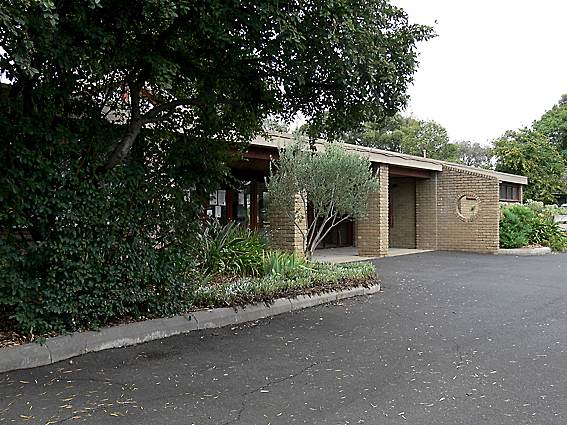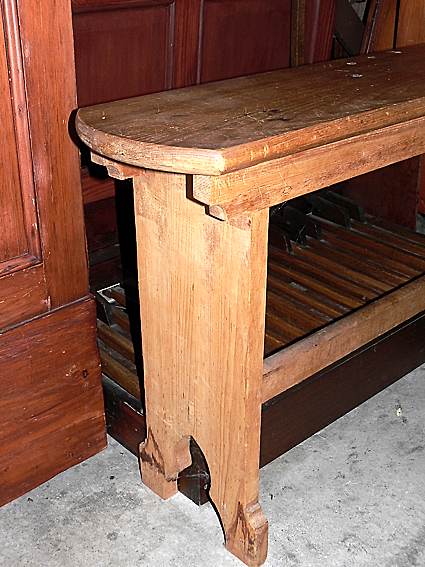
Our Saviour's Lutheran Church, Knoxfield: the exterior
[photograph by John Maidment (28 February 2013)]

Our Saviour's Lutheran Church, Knoxfield: the exterior
[photograph by John Maidment (28 February 2013)]
Historical and Technical Documentation by John Maidment
© OHTA, 2013 (last updated March 2013)
Our Saviour's congregation dates back to 1974. The church building, dedicated on 6 March 1983, has large windows that enable external views into gardens and courtyards.

The organ when located in the first bay of the south aisle
of St Patrick's Cathedral, Melbourne 1868-c.1882
[Illustrated Australian News for Home Readers, 27 February 1871]
The organ includes the casework and some pipework from an organ built in England in the first half of the 19th century. It is possible that it came from the West Country and may have been the work of the organbuilder John Smith, of Bristol as it visually resembles some of its work (such as the 1815 organ for Penn Street Tabernacle, Bristol) and the firm had a representative in Melbourne Henry Smith 1853-55. When it arrived in Melbourne, it was certainly second-hand and maybe one of the instruments advertised in the newspaper The Argus. It appears to have been installed in the earlier St Patrick's Church, Melbourne but would have had to be removed and stored before the opening of the nave of St Patrick's Cathedral, Melbourne in 1868, where it is thought to have been located in the south aisle. The previous church on the site had been demolished and materials were used in constructing the Cathedral.
St Patrick's Cathedral acquired a new organ that had been started by Robert Mackenzie, but completed by George Fincham and it was opened in 1880. The first organ then went to St Brigid's Catholic Church, North Fitzroy, where it was installed by George Fincham and opened on 3 December 1882.1 St Brigid's acquired shortly afterwards a far more substantial organ from Alfred Fuller, so it was then moved to the Congregational Church, Castlemaine where it was installed by Fuller in 1886.2 At some stage, a Swell Organ of four stops had been added; it appears to be earlier than Fuller's work, which included modifications to the console and action (much of which is constructed in Australian cedar) and could have been carried out by James Moyle or Jesse Biggs. The compass of the Great Organ was probably reduced to CC, involving the provision of a new slider chest. None of this work has been documented in any accessible sources. J.B. Crook, an amateur organbuilder from Bendigo, made modifications to the wind system in 1902.

Congregational Church, Castlemaine: the organ showing original case and pipe decoration
[photograph by John Maidment (February 1966)]
In mid-1966, the casework and façade pipes were repainted by local people, greatly to their detriment. A photograph taken early in 1966 shows the previous decorative treatment to the case and dummy façade pipes, which were shortly afterwards covered in estapol and gold and white paint. The pipes had then been elegantly stencilled in green leaf patterns and the woodwork of the case had been embellished with painted decoration.3

Congregational Church, Castlemaine: the organ following the façade redecoration c. March-May 1966
[photograph by Robert Tobin (June 1966)]
Following the formation of the Uniting Church in the mid-1970s the building became redundant and it was auctioned in 1978. The organ was acquired by Dr Oliver Burger, of St John's Lutheran Church, Geelong and placed in storage there. John Stiller carried out a full documentation of this organ while it was in Geelong and found, from pipe markings, that the pipework was quite old and probably dated from earlier in the 19th century, including random pipes from a wide variety of sources, some from a Twelfth, Sesquialtera and Cornet.4 The casework is stylistically based upon models prevalent in England in the earlier years of the same century with its three towers and two flats. While the console furniture is of Australian cedar, the scrolled keycheeks are of mahogany and most of the drawstops turned from rosewood, predating its arrival in Australia. The pedalboard, with short natural keys, is also of oak.

Our Saviour's Lutheran Church, Knox: the organ following the regilding of the façade pipes
[photograph by John Maidment (28 February 2013)]
The instrument was installed at Knox in 1985-86 by members of the congregation. Australian Pipe Organs Pty Ltd carried out a renovation to the pipework, windchests and action in 1997, assisted by a grant from Heritage Victoria, who had registered the organ as being of considerable significance in January 1997. Marc Nobel finally regilded the dummy wooden façade pipes in 2000, again assisted by a Heritage Victoria grant.5
| GREAT Open Diapason Stopd Diapason Dulciana Principal Flute Fifteenth Swell to Great SWELL Stopd Diapason Keraulophon Principal Oboe PEDAL Bourdon Great to Pedal |
[8] [8] [8] [4] [4] [2] [8] [8] [4] [8] [16] |
open wood bass gvd.bass TC gvd.bass TC |
Compass: 56/29
Mechanical key and stop action
2 composition pedals to Great
Trigger swell lever6

Our Saviour's Lutheran Church, Knox: detail of the organ case
[photograph by John Maidment (28 February 2013)]

Our Saviour's Lutheran Church, Knox: the console
[photograph by John Maidment (28 February 2013)]

Our Saviour's Lutheran Church, Knox: the left-hand stop jamb
[photograph by John Maidment (28 February 2013)]

Our Saviour's Lutheran Church, Knox: the right-hand stop jamb
[photograph by John Maidment (28 February 2013)]

Our Saviour's Lutheran Church, Knox: the composition pedals and lever swell pedal
[photograph by John Maidment (28 February 2013)]

Our Saviour's Lutheran Church, Knox: the bench supplied by Alfred Fuller
[photograph by John Maidment (28 February 2013)]

Our Saviour's Lutheran Church, Knox: the action behind the music desk
[photograph by John Maidment (28 February 2013)]

Our Saviour's Lutheran Church, Knox: the swell roller board
[photograph by John Maidment (28 February 2013)]

Our Saviour's Lutheran Church, Knox: the Great stop action
[photograph by John Maidment (28 February 2013)]
1 The Advocate 25 November 1882
2 Castlemaine Leader 22 September 1886, 6 October 1886
3 Noted by John Maidment during a visit in February 1966
4 John Stiller, Detailed Documentation of Pipe Organ Formerly in the Congregational Church Castlemaine Victoria; investigated 2nd September 1978, 22nd January and 18th April 1979. Camberwell: Organ Historical Trust of Australia, 1980.
5 From a pamphlet issued by the church
6 Specification noted by John Maidment February 1966, February 2013